Zotac's Ion: The World's First mini-ITX Ion Board
by Anand Lal Shimpi on May 12, 2009 12:00 AM EST- Posted in
- GPUs
SYSMark 2007 Performance
Our journey starts with SYSMark 2007, the only all-encompassing performance suite in our review today. The idea here is simple: one benchmark to indicate the overall performance of your machine.
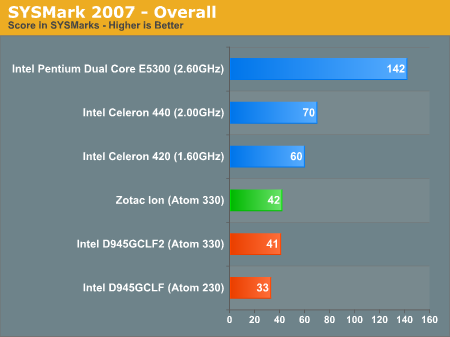
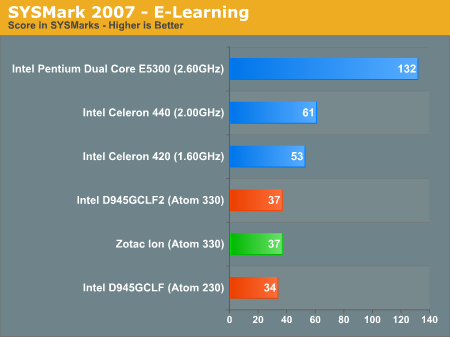
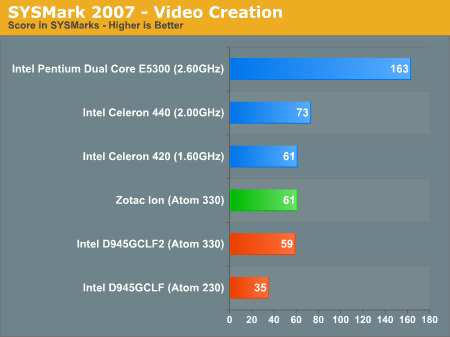
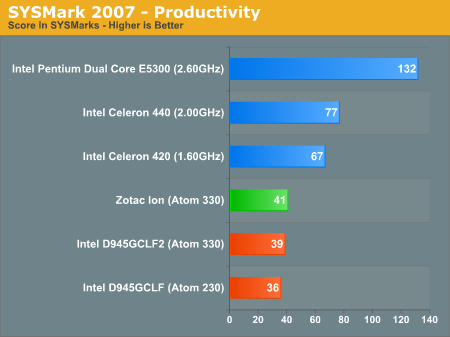

There's a 27% performance improvement realized in SYSMark 2007 when going from the single-core Atom 230 to the dual-core Atom 330. Even the Atom 330 is outperformed by the lowest end Celeron 420 by 43% however.
Note that in general application usage there's no significant performance difference between the Zotac Ion and the Intel D945GCLF2.
And before you get any ideas of replacing a modern day, low-end system with an Ion look at the E5300 score. The E5300 offers 3.4x the speed of the Atom 330. Granted you need a more expensive motherboard but compared to the Zotac Ion, it's not that much more expensive.
Adobe Photoshop CS4 Performance
To measure performance under Photoshop CS4 we turn to the Retouch Artists’ Speed Test. The test does basic photo editing; there are a couple of color space conversions, many layer creations, color curve adjustment, image and canvas size adjustment, unsharp mask, and finally a gaussian blur performed on the entire image.
The whole process is timed and thanks to the use of Intel's X25-M SSD as our test bed hard drive, performance is far more predictable than back when we used to test on mechanical disks.
Time is reported in seconds and the lower numbers mean better performance. The test is multithreaded and can hit all four cores in a quad-core machine.
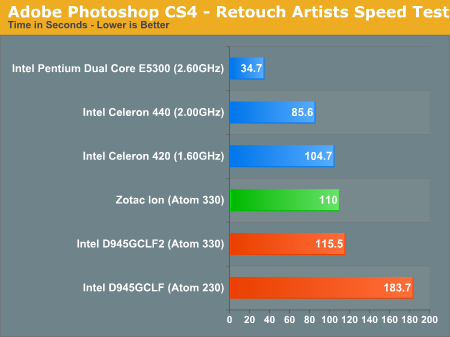
This test was particularly surprising, because with four threads the Atom 330 is able to actually come within striking distance of the Celeron 420's performance - at a considerably lower power consumption. Once we transition to an even more multi-threaded environment where multi-core processors can always maintain a significant performance advantage over their single core brethren then it may be more efficient to toss a few Atom-cores at a problem than something like the Celeron 420. Hmm, perhaps Larrabee will be more useful than we thought...
The single-core Atom 230 is horrendously slow in this test. While the 330 could masquerade as a very low end microprocessor from the modern era, the 230 takes significantly longer to complete our test. No thanks.
The difference between Ion and the D945GCLF2 is negligible.










93 Comments
View All Comments
bobvodka - Wednesday, May 13, 2009 - link
While I know it's only at the RC stage, it might be intresting to see how this plays with Win7, if only as a nod to the future and with regards to how it performs against XPlemon8h8ead - Wednesday, May 13, 2009 - link
Thanks for a good job in optimizing control over the environment. It is not easy to create apples-to-apples tests.I would have been interested in seeing the same H/W configurations running one of the popular Linux distros (E.g. Ubuntu). It has been my observation that the Linux kernel multithreads more efficiently than Windows but those were purely compute-bound applications that I was comparing and the benchmarks are 8 years old on very dated H/W platforms (obsolete). I realize that both Windows and Linux kernels have improved vastly since then.
Is your HTPC speced out here anywhere? Just curious.
sysdump - Wednesday, May 13, 2009 - link
I want to see HD H264 content decoded using CUDA! To see if it can handle non DXVA compatible videos.mvrx - Wednesday, May 13, 2009 - link
I've been using an Atom 330 system as a DD-WRT router.. cost me only $150 and is probably 15x faster than any Dlink or linksys on the market.. People really need to pay attention to this possibility.mindless1 - Wednesday, May 13, 2009 - link
Presumably you're comparing against Dlink and Linksys consumer grade routers, that are meant for light use. In such a scenario why would it need to be 15X faster and had you done latency tests that quantify the difference? Checking latency on a router running DD-WRT I find the router latency insignificant compared to the rest of the nodes along a typical connection, and that when the router is even doing QOS concurrent to P2P transfers.I'd think a board like this to be quite overkill for mere routing, it might be nice though to have a few more features possible like DNS caching, web proxy, advanced firewall rules, web/mail server.
JoKeRr - Wednesday, May 13, 2009 - link
For $80 with 3 SATA ports and add in some ram and 3 hard disks, this will make a decent NAS file server with linux installed.I use a PS3 in the living room, it used to be a old mac mini. Right now I definitely miss the iPhone remote with iTune in the mac mini. PS3 is great for movies, but for not so with web content. I use PS3 media server to stream movies from my PC to the PS3, it also performs transcoding on the content that PS3 doesn't recognize (mkv). My desktop is P4 3.0C overclocked to 3.5GHz, and it has no problem transcoding mkv movies in 720p resolution (max bit rate I saw was around 15Mbps), I would really like to know how the dual core atom performs on the transcoding front with PS3 media server. If it works well, it will be a very nice compliment to the PS3 system.
Thank you!
NullSubroutine - Saturday, May 16, 2009 - link
I thought I'd like to throw out that that with MKV files you can mux them (like with tsMuxer) to MT2S files which can then be renamed to MP4 to play on PS3.Muxing takes less than a minute usually and doesn't convert the video just takes it out of the MKV container file.
It may be easier to do this with your files than have them transcode on the fly.
ViRGE - Tuesday, May 12, 2009 - link
If only it had component out. The HDMI port is nice, but I had a RP-CRT; I'd love to replace my HTPC box with something like this, but the lack of component out is a killer.moozoo - Tuesday, May 12, 2009 - link
I believe the ION platform supports CUDA.Please run some CUDA benchmarks and those H264 video encodings using BadaBOOM on this motherboard.
The ION chipset (MCP79) has very low latency between the GPU and the main memory. This makes it possible to perform audio functions on the GPU.
See http://forums.nvidia.com/index.php?showtopic=92290">http://forums.nvidia.com/index.php?showtopic=92290
JarredWalton - Tuesday, May 12, 2009 - link
From the conclusion:"I did try some CUDA applications on the Zotac Ion board and they were definitely faster than using the CPU alone. While our x264 test managed around 12 fps on the Zotac Ion, using Badaboom I was able to encode at just under 20 fps."